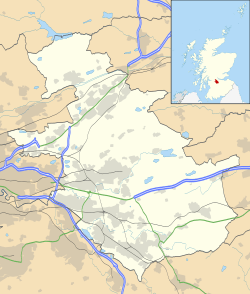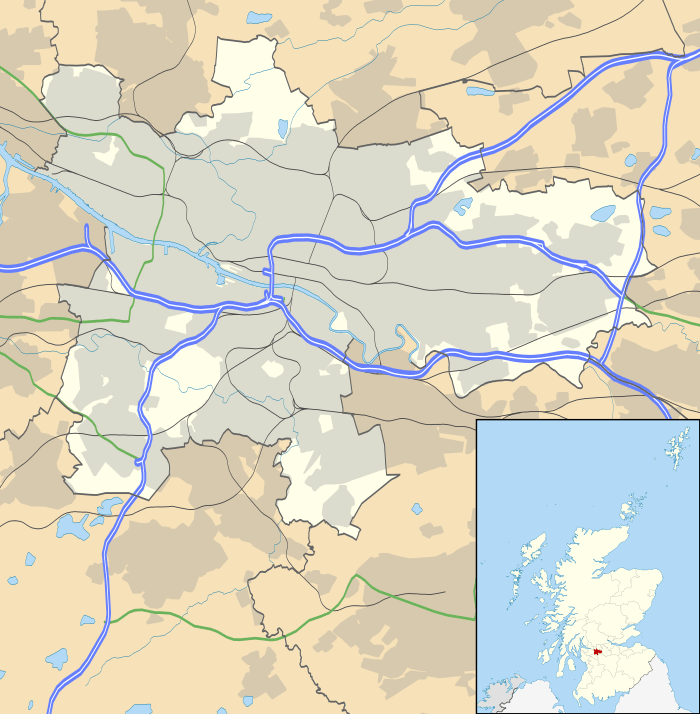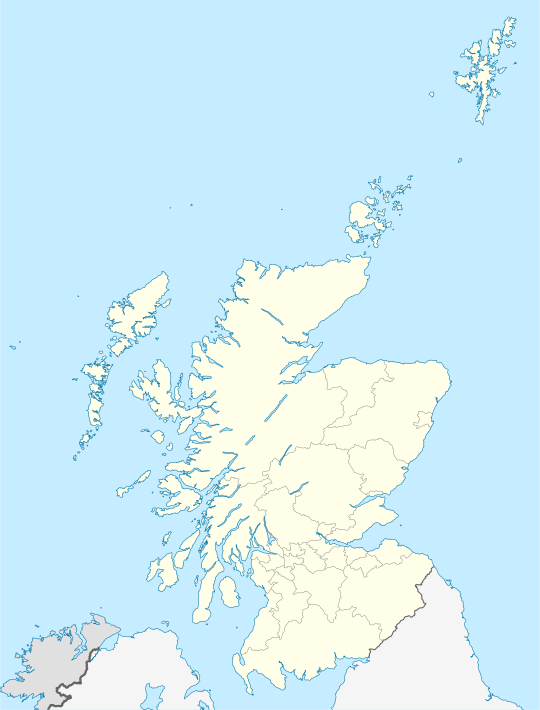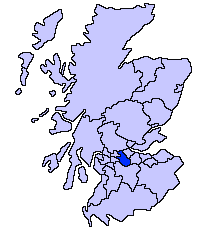Moodiesburn
Moodiesburn is a small town in Scotland, located 8 miles (13 kilometres) north-east of Glasgow city centre, in the North Lanarkshire council area. It is situated on the A80 road, between Stepps and Cumbernauld.[2]
| Moodiesburn | |
|---|---|
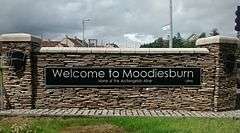 Entrance to Moodiesburn via the A80 | |
| Population | 6,900 [1] (mid-2012 estimate) |
| OS grid reference | NS6960871434 |
| Lieutenancy area |
|
| Country | Scotland |
| Sovereign state | United Kingdom |
| Post town | GLASGOW |
| Postcode district | G69 |
| Dialling code | 01236 |
| Police | Scotland |
| Fire | Scottish |
| Ambulance | Scottish |
| UK Parliament | |
| Scottish Parliament | |
History
The etymology of the name is probably from the common Scottish surname Moody.[3] Several old documents show Moodiesburn with various spellings including maps by Richardson, Forrest,[4] and William Roy.[5] Moodiesburn (or Mudiesburn) was formerly part of the parish of Cadder.[6] The New Statistical Accounts recorded 30 families and 143 people in 1836.[7] In 1846 there were reported to be 35 houses with 220 people living in them.[8] Towards the end of the 19th century the population fell to as low as 150.[9] The town was developed in the 20th century with employment in coal mining and around psychiatric institution Stoneyetts Hospital.[10] In the 1930s,[11] wooden houses were constructed on the estate of Gartferry House.[12]
Auchengeich mining disaster
In September 1959, 47 men lost their lives in a coal mine near the village of Moodiesburn when a faulty fan purifying the air in the colliery went on fire due to an electrical fault.[13] The men were in bogies travelling to the coal face to start work, and due to the intense smoke they were abandoned just a few hundred yards from safety. The mine was eventually flooded to put out the fire; there was only one survivor from the crews. The mining accident was one of the worst within the UK in the 20th century, widowing 41 women and leaving 76 children without a father.[14]
The First Minister of Scotland Alex Salmond unveiled a memorial on 18 September 2009 at Moodiesburn.[15] Norman Buchan wrote a song, "Auchengeich", about the disaster, recorded by Dick Gaughan and The Easy Club.
Aftermath and economic decline
Mining was shuttered following the disaster. Stoneyetts ceased operation in 1992, followed by Scottish Power and Reekie Plant Hire sites closing in 1996. A 1999 article in The Observer lamented Moodiesburn's lack of local employment, as well as the increasing disaffection of its younger residents:
"A good number of young families are blatantly poorer than our grandparents. They have less purchasing power because they live on benefit [...] Moodiesburn is a quiet island whose ageing inhabitants pass the time by looking after one another, visiting, retelling the past. The current that made people get up in the morning has been switched off. The young are null. They use drugs, spray graffiti. But they are quiet islanders, too, living invisibly at home with their disks and keyboards."[16]
— Neal Ascherson, 10 October 1999
Auchengeich sewage works and the Moodiesburn House Hotel – previously the Bedlay Dowager House – were closed in 2003 and 2008, respectively.[17][18] Two career options remain in the area: landscaping product supplier Charcon Scotland (part of Aggregate Industries), and food processing company Devro.[19]
Landmarks
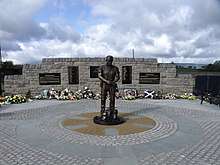
.jpg)
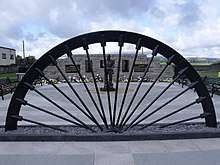
Bedlay Cemetery is the local cemetery for Moodiesburn. The nearby Bedlay Castle has stood since the late 16th century.[21][22]
The suburb includes a community centre and library, a miners' welfare club (the Auchengeich Miners Welfare), a multi-denominational school (Glenmanor Primary), a denominational school (St. Michael's Primary), a Church of Scotland parish church, a Roman Catholic church, and an independent evangelical church called New Beginnings. There is also the Silver Larch public house, a Knights of Saint Columba social club and a coffee shop called The Coffee House.
The community's original 1950s council house builds comprise an area known as "Old Moodiesburn" (though a substantial number of those homes are now privately owned). A batch of houses with updated resources were constructed in the 1960s, and dubbed the "electric scheme" by locals. Modern homes have since been developed in this area of Moodiesburn, including by Taylor Woodrow (1989), Persimmon (1997) and Lovell (2016). The opposite end, by Devro headquarters, is composed mostly of private residences by Christian Salvesen (1970), Tay/Wimpey (1992), Bellway (1995) and Persimmon (2006 and 2018). Miller Homes are set to build on the former Stoneyetts Hospital site as of 2019.
A small estate of new council builds was erected in the midst of the Salvesen area in 2013.
References
- "Estimated population of localities by broad age groups, mid-2012" (PDF). Retrieved 3 January 2018.
- "OS 25 inch 1892-1949". National Library of Scotland. Ordnance Survey. Retrieved 26 October 2017.
- Drummond, Peter, John (2014). An analysis of toponyms and toponymic patterns in eight parishes of the upper Kelvin basin (PDF). Glasgow: Glasgow University. p. 172. Retrieved 3 July 2017.
- "Old County Maps". NLS. Retrieved 27 January 2018.
- "Roy's map of the Lowlands". NLS. Retrieved 27 January 2018.
- Wilson, John Marius (1882). The gazetteer of Scotland. Edinburgh: W. & A.K. Johnston. p. 65. Retrieved 27 February 2018.
- Society for the Benefit of the Sons and Daughters of the Clergy (1845). The new statistical account of Scotland. Edinburgh and London: W. Blackwood and Sons. p. 408. Retrieved 31 December 2017.
- Lewis, Samuel (1846). A topographical dictionary of Scotland ... London: S. Lewis and Co. p. 277. Retrieved 28 February 2018.
- "Moodiesburn and Bridgend". Monklands Memories. Retrieved 24 February 2018.
- "Moodiesburn". Gazetteer of Scotland. Retrieved 24 February 2018.
- Kidd, Neil. "Moodiesburn". The Story of Chryston. Retrieved 24 February 2018.
- Historic Environment Scotland. "Gartferry House (45219)". Canmore. Retrieved 28 February 2018.
- "Auchengeich Mining Disaster". Monklands Memories. Retrieved 24 February 2018.
- "Community pays tribute to Auchengeich mining disaster victims - Local Headlines". Kirkintilloch Herald. 11 September 2007. Retrieved 22 January 2012.
- Scottish Mining Website. "Auchengeich 1959 - Scottish Mining Website". scottishmining.co.uk.
- Ascherson, Neal (10 October 1999). "Take a look. Take a long look". The Observer. Guardian Media Group.
- "Scottish Water fined again". The ENDS Report. 30 September 2003. Retrieved 6 October 2019.
Auchengeich sewage treatment works... closed in March.
- "Crews in 9-hour hotel fire battle". Cumbernauld News. 19 March 2008. Retrieved 6 October 2019.
- "Taking a look back at Moodiesburn". Kirkintilloch Herald. 28 March 2006. Retrieved 6 October 2019.
- "Welcome home - iconic miner returned to rightful place at Auchengeich". Monklands Memories. Archived from the original on 25 February 2018. Retrieved 24 February 2018.
- Mason, Gordon The Castles of Glasgow and the Clyde, Goblinshead, 2000 (p.51)
- Coventry, Martin The Castles of Scotland (3rd Edition), Goblinshead, 2001 (p.83)
